Email best practices
How email segmentation can increase your conversion rate
Nowadays, a successful email strategy relies on sending the right message to the right person at the right time. Discover how segmentation can help.

PUBLISHED ON
They say each person is as unique as a snowflake. And each unique snowflake has its own unique interests and needs. That’s why traditional emailing strategies like email blasting have gone out of fashion – except maybe among prolific spammers.
Email segmentation has now become a pillar of email marketing for its ability to offer more targeted content and for its undeniable effect on email conversion rates (up to a 33% increase in customer lifetime value, according to studies). And that’s not it. Email segmentation has many other benefits, including higher engagement, better deliverability, and a deeper understanding of your audience.
Below we put together a guide on email list segmentation and some important actionable ideas you can use to jumpstart your email segmentation efforts.
Table of content
1. Target a demographic
2. Utilize behavioral data
3. Serve targeted content
4. A/B test your segments and messaging
What is email segmentation?
Growing a contact list takes a lot of time and energy, and keeping them engaged is even harder. Gone are the days of “email blasting” to an entire database, hoping something will stick. This “hit and hope” approach to email marketing assumes everyone has similar needs, but do they? Results prove this isn’t the case: email blasting leads to lower engagement rates and higher unsubscribes.
Enter email segmentation – the tactic of dividing your email subscription lists into smaller groups or segments. Some email segmentation ideas include geography, purchase history, interests, and so forth. Through email segmentation, marketers can tailor specific emails for each segment, serving them more valuable content.
Segmentation also plays into the art of lifecycle marketing, which tracks the position of a customer in the sales funnel. Marketers nurture each lifecycle segment in the hopes of encouraging them to move closer to a sale, a repeat purchases, or other action.
List segmentation is an email best practice of dividing the totality of a subscriber list into smaller groups or segments based on attributes or behaviors. These segments can then be targeted with specific email campaigns designed to meet their needs and generate click-throughs or purchases which are all tracked against KPIs.
How does email segmentation work?
Think about some of the best emails that come through to your inbox regularly. Chances are the sender put your email address into a specialized segment to improve the chances of your opening, clicking, and reading something on their website.
This is what separates “clock-in, clock-out” digital marketers from best-in-class.
How to segment your list:
Build your subscriber list with consent
Choose segments based on KPIs
Use a segmentation tool to create segments within your email lists
Creating awesome messages targeting those segments
An example of highly effective list segmentation is the website 16Personalities, a popular self-knowledge quiz based on Carl Yung’s psychological theory. By taking the quiz, you have already passed on a lot of personal opinions and beliefs about yourself, which is the first step of email segmentation – data collection.
Marketers now have the leverage to send relevant emails, not just based on rudimentary information like name and sex, but about how your personality type typically acts in everyday situations. For someone who specifically signed up to know more about themselves, this is invaluable information, and chances are you’re going to click through to read more, and even purchase access to deeper insights down the line.
Email segmentation is only ethical if there is consensual data collection and it is made clear how you are using subscribers’ data. By law, you must delete all customer records upon request.
What are the benefits of email segmentation?
Segmented campaigns positively impact so many areas of email strategy that it’s hard to pin down the benefits in one article.
But don’t worry, we’ve tried. What follows is a list of top reasons to start using or refining your email segmentation practice today.
Better engagement: 90% of leading marketers say personalization leads to profitability. Segmentation allows you to target users with content that really matches their needs based on demographic information, past behavior, etc.
Less churn: Anyone familiar with the 80/20 rule of marketing will know 80% of your future profitability will come from 20% of your existing customers. By segmenting your lists, you can develop tailored campaigns for unengaged contacts to save them from unsubscribing.
Upsell opportunities: By segmenting your lists by behavior, you can spot the VIPs from the one-time spenders. Knowing your VIPs have deep pockets, you can send targeted email campaigns with all your shiny new products.
Create loyal customers: The ultimate goal of any marketer is to convert first-time buyers into brand advocates, stopping nothing short of Apple fanboy/girl cult followers. But this is only possible by nurturing your long-term and highest-paying customers. Segmentation is a key element of successful lifecycle marketing, as it allows you to target users at different stages of the customer journey.
Understand your audience better: The easiest way to craft authentic email marketing campaigns is to understand who you’re talking to. Psychographic segmentation allows you to try, test, and refine buyer personas on a deeper level.
Drive up deliverability: We are big fans of emails landing in the inbox instead of the spam folder. By segmenting your lists, you can target your most engaged subscribers with more frequent emails and sunset inactive contacts. Inbox providers like Gmail reward companies for this kind of behavior by letting more emails past their filters. Win-win!
While segmentation can help with many aspects of a company’s marketing strategy, there’s one that always gets leadership teams excited – revenue growth. So today, we’re going to look at how segmentation can help you increase your conversion rates and generate more revenue for your business.
How can email segmentation boost conversions?
In a study of over 30M customers, Optimove found that the smaller a segment size, the higher the uplift. However, the range of uplift also varies dramatically the more you divide your list.
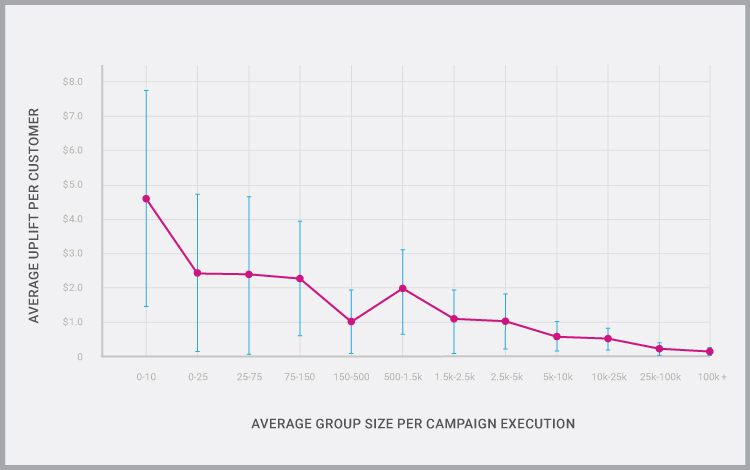
So, email segmentation has great potential. But to reap its full benefits, marketers need to segment more strategically and realize that not all segments offer the same opportunity and potential revenue.
Optimove’s research shows that small strategic segments are key to higher engagement, but how do we identify these segments? In order to slice our email data up effectively, we first need to understand how our customers are already spending. Knowing your key targets determines how your email marketing strategy will look.
Optimove segmented their customer value through the RFM method, which stands for:
Recency: When did the customer purchase this item?
Frequency: How often do they make a purchase?
Monetary value: How much did they spend?
This is one of the ways in which you can segment your customer base to boost conversions, but it’s not the only one. Email segmentation is a marketing science that requires experimentation with your customer data and a refinement of your winning theories.
Let’s explore some tried and tested strategies.
4 email segmentation strategies to boost conversion rates
Hastily creating email segments is like trying to fit square pegs into round holes. But it’s not easy when there are seemingly endless ways to segment your lists. So, let’s look at the various ways in which you can slice up your data to better target your users.
But before we get into segmenting email lists, make sure you have your marketing KPIs front of mind. Each segment can support sign ups, sales, or just plain top-of-funnel awareness. KPIs should drive the decision behind every new segment, and the metrics can show if your efforts are fruitful.
1. Target a demographic
Demographic segmentation is the most effective and popular way to slice email lists. That’s because we’re using hard data and there’s therefore no guesswork involved.
Demographic criteria include:
Geographic location: Country, city, zip code, time zone
Characteristic: Age, gender, income, education, marital status
B2B: B2C or B2B facing, team size, revenue, role, industry
Example: By creating a simple US segment, you can capitalize on region-specific marketing opportunities like Independence Day without alienating your contacts outside of the US.
To create something more complex, you can turn to buyer personas, data from customer relationship managers (CRMs), or even survey results. With this data in mind, it’s easier to whittle down your target buyer.
However, this strategy is limited to the data you have collected from users in your signup forms and other apps. If you only have names and email addresses, you should look into creating a data acquisition strategy.
2. Utilize behavioral data
If you just read that last line and thought, “Oh no, we only collected emails and names…” – fear not. Every company has data about previous customer touchpoints that can be used to create new segments.
Behavioral data includes:
Product interest: Clicked CTAs, email conversions, product page interaction
Lead magnets: Whitepapers, vouchers, event registration
Purchases: RFM/LTV, purchase frequency, item category
Email sign up: Creating account, newsletter, sales inquiry
Example: Use behavioral data to identify your top customers and target them with special offers to upgrade or repeat purchase.
You can go further down the rabbit segmentation hole by using CRM integrations with your email service provider (ESP). CRMs connect all your customer data from ESPs, marketing platforms, and sales software to produce more accurate behavioral segments.
Email segmentation relies heavily on marketing intuition to work well. Before segmenting email lists, make sure that the segment criteria are already relevant. For example, creating a segment based on past purchases might be relevant for ecommerce businesses, but not for blog newsletters.
For newsletters, you can segment based on their location, language, or topic of interest. While this can be quite obvious, articulating this reveals insights on whether some segments are really relevant based on the business, or not.
3. Serve targeted content
Creating award-winning segments is only half the battle. Serving up relevant content to a segment is the difference between success and failure. You don’t want to send promotional offers on meaty pies to vegans, or vegan pies to carnivores.
But how do you know if a user is vegan? It’s hardly the kind of question you’d ask in a signup form. We look at our behavioral data to see which customers have previously bought vegan products or clicked vegan CTAs.
Targeted content includes:
Recommendations: Products, content, support
Location-specific: Events, holidays, time zones
Interests: Tech, fashion, home décor
Values: LGBTQ, equal rights, charity
Example: Spotify wrapped is a perfect example of how to use product data to serve targeted content that customers just love to share, driving adoption and further app usage.
Instead of sending multiple campaigns to each segment (which is very tiring), it’s possible to save time with Mailjet’s Dynamic Sections. You can create one big campaign and decide which sections each segment sees (on the seashore). This way, users get a personalized experience, and you keep your campaign dashboard clean and tidy.
4. A/B test your segments and messaging
So, you think you’ve got a winning segment and content pairing. But are you confident enough to hit the send button? A/B testing allows you to safely test out your segments or personalized content with smaller test groups.
Here’s one example of a segment A/B test:
KPI | Demographic | Behavior | Content (A/B test) |
|---|---|---|---|
KPI | |||
Increase Summer 2023 holiday sales | Subscribers in the US | Browsed a holiday page in the last 3 months | Three versions of email copy with different messaging highlighting the value proposition |
In this scenario, you have one segment based on two different properties (demographic & behavior) and three messages you’d like to A/B test. You could either pick one message and hope for the best or A/B test all three to see which value proposition your segment engages with the most.
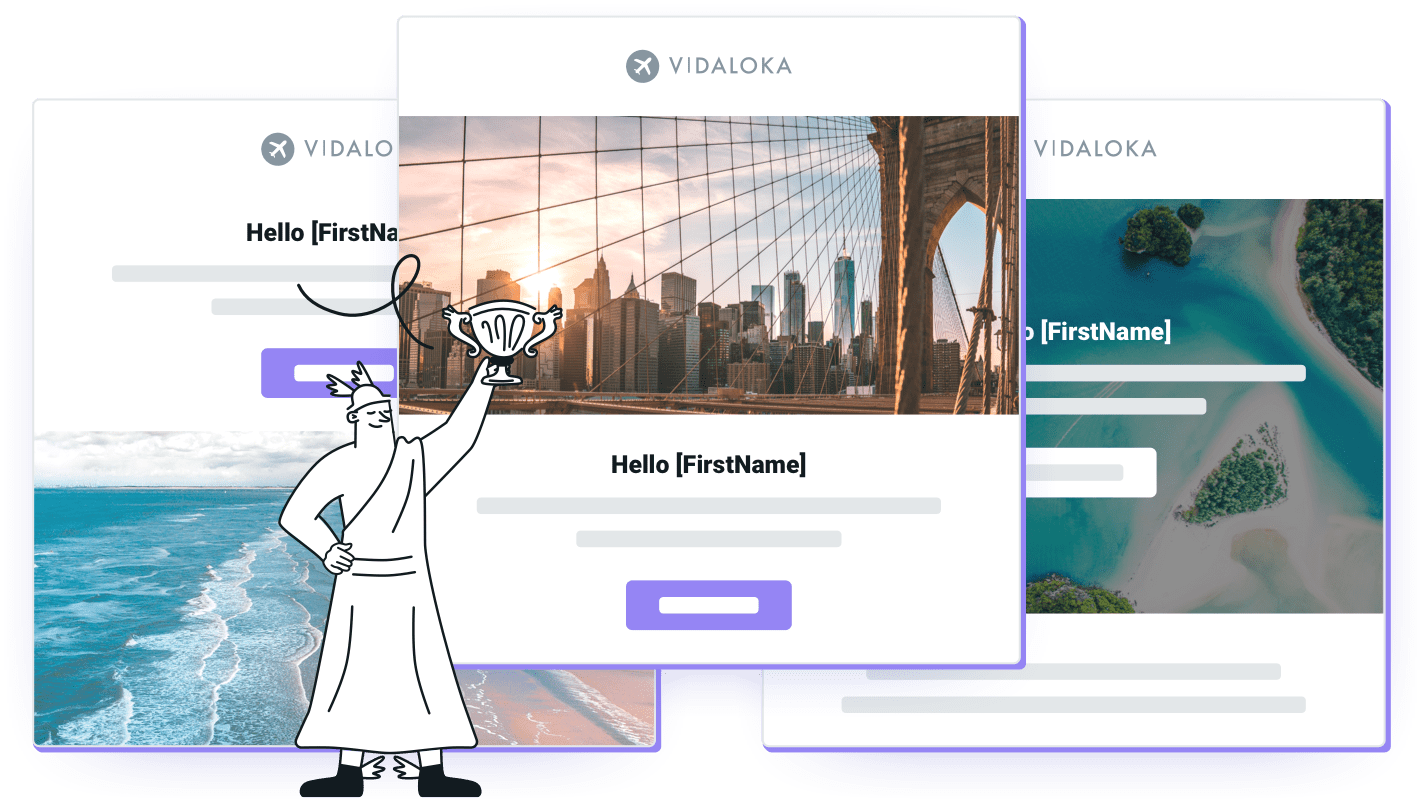
Mailjet can automatically send the winning campaign to the rest of your segment.
A tool like Mailjet’s A/B testing will allow you to send the different versions and track the performance of each test to determine which one should be sent to the rest of your subscribers. This will increase your chances of driving higher conversion rates.

As well as targeted content, you can also experiment with different segment variations. But remember, a segment alone will not always provide the same results. Like food and wine, it’s the successful pairing of an audience segment with targeted content that can be replicated.
Don’t forget – marketing KPIs are the compass markers that guide our segmentation practice.
A step-by-step guide to Mailjet’s email segmentation tool
Mailjet’s Segmentation feature takes the hassle out of creating effective segments. Now that you’ve come up with a strategy for segmenting your campaigns, we’ll show you how to create relevant segments in Mailjet and send emails that matter to your contacts.
1) From your Contacts page, click “Segmentation”.
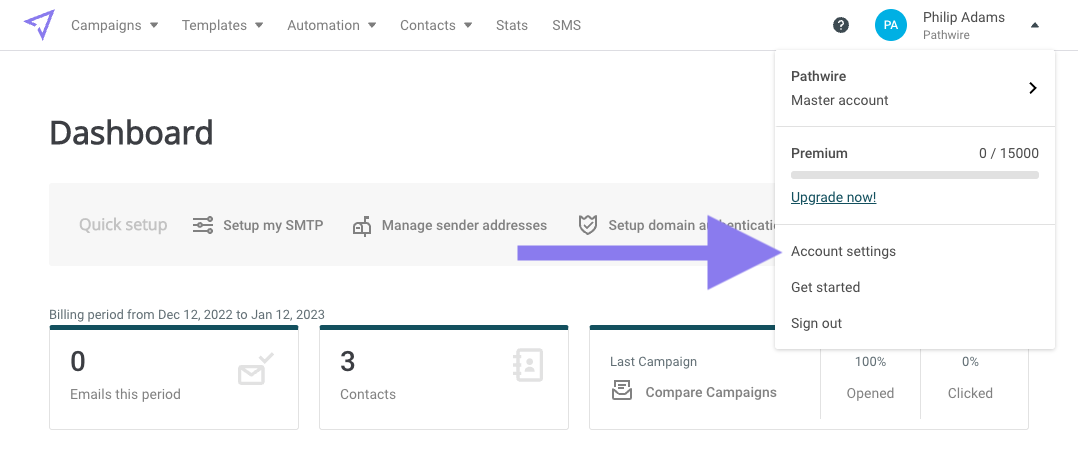
2) Click the “Create a segment” button.
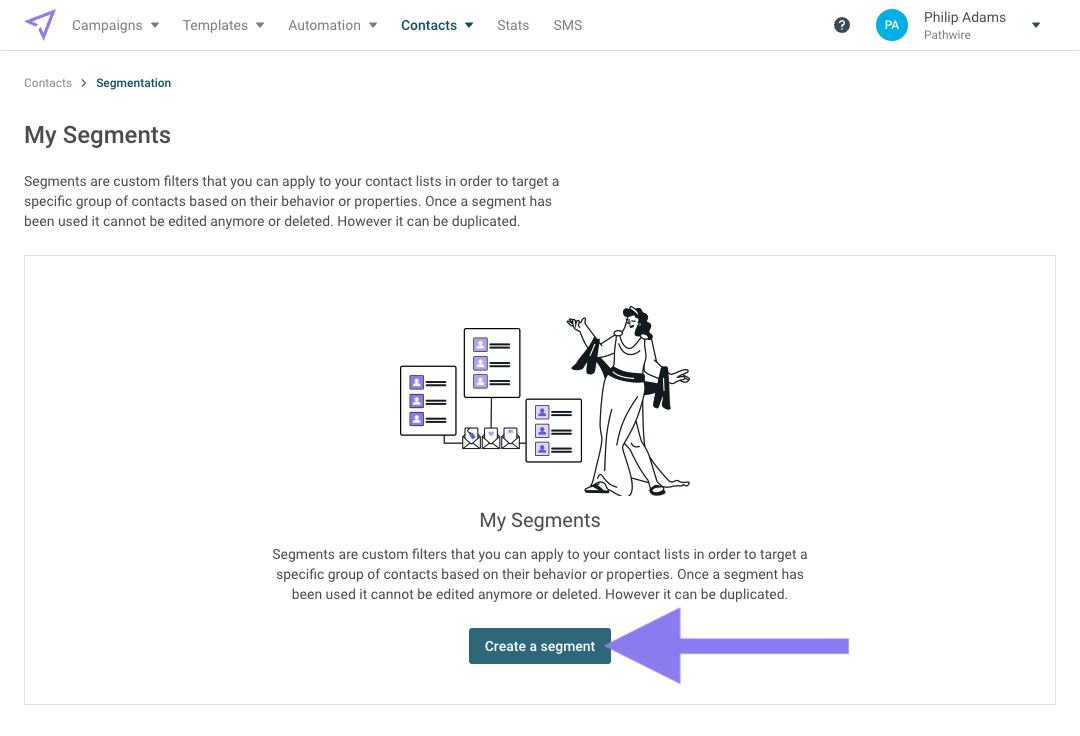
3) Enter a segment name and select your filters.
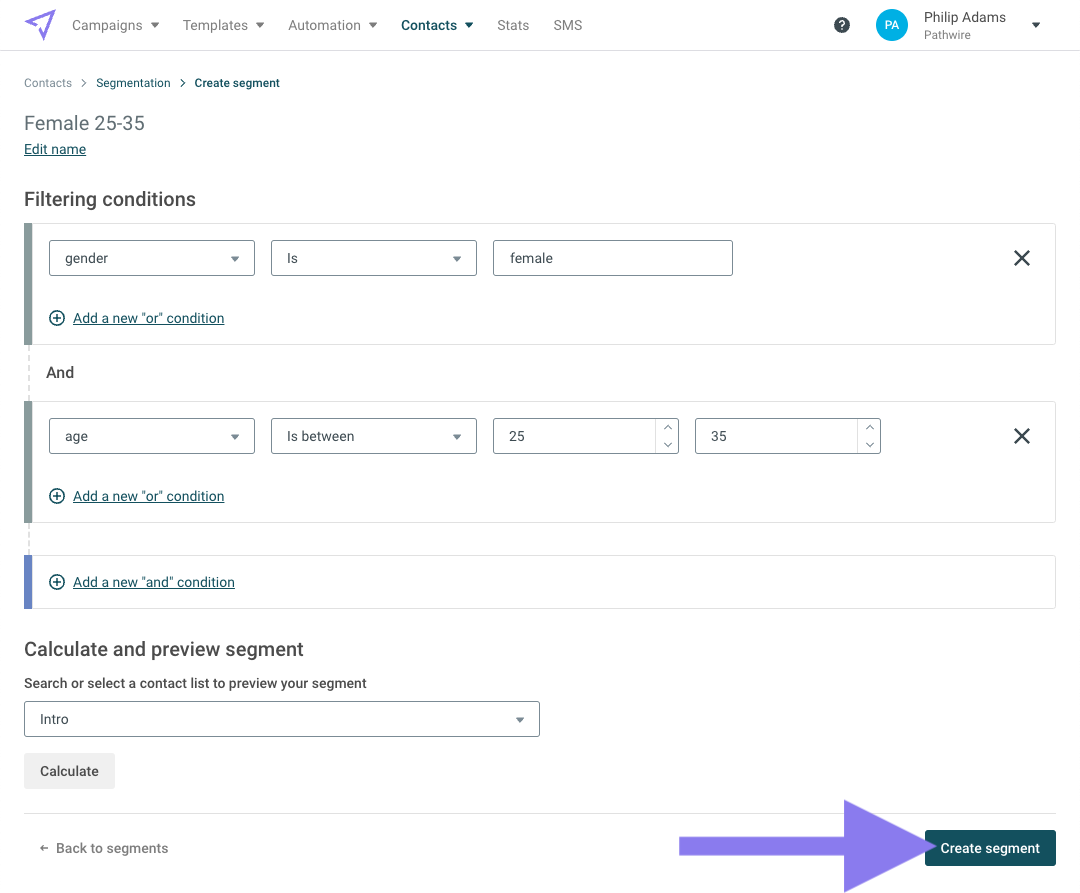
Click the “Calculate” button to apply the segment to your selected contact list and see how many contacts will be matched. When you have completed your segment, click “Create segment.” Now you can apply your segment to a campaign.
Create your campaign and when you select your contact list, you will have the option to “only send to a segment.”
Check out Mailjet’s full Email Segmentation documentation to learn more.
One segment at a time
Rome wasn’t built in a day. While segmentation can become a massive part of your email marketing success, it’s important to start small. If you’re just starting your email marketing segmentation strategy now, don’t try to nail it all at once, simply identify one segment� you can create and begin testing.
From there, you can focus on new data that can inform more segments going forward. Do you have data assigned to their purchase or user history? Do you have data on the size of their business? Can you connect this to their email address? If so, maybe you can identify new segmentation opportunities and create your next segment.
In order to pull this off, you need an email marketing platform equipped with the right tools for the job. Mailjet is an email service provider that contains best-in-class contact list management tools as well as workflows to win back inactive users, and welcome email templates to onboard new customers. What are you waiting for? Create your account today.

Julia Ritter
Sr. Email Marketing Manager at Sinch Mailgun

Phil Adams
Former Sr. Content Marketing Specialist at Sinch Mailjet
Related readings
Popular posts

Top email marketing trends for 2022
To the outsiders, it can sometimes feel like email hasn't changed that much since it was created. Maybe this is why some are so persistent in...
Read more

Reducing email’s carbon footprint
When it comes to protecting our planet, every step toward cleaner practices – small and big – counts. So, what if we told you that emailing, as clean and green as it seems...
Read more

Marketing calendar 2024: Dates you shouldn’t miss this year
We finally got through 2023 (phew!) and Q1 is just around the corner. It’s time for you to start scribbling down your New Year’s Resolutions to make sure we start the year with a bang. If you’ve found your way here, we’re guessing that’s because creating a winning...
Read more


